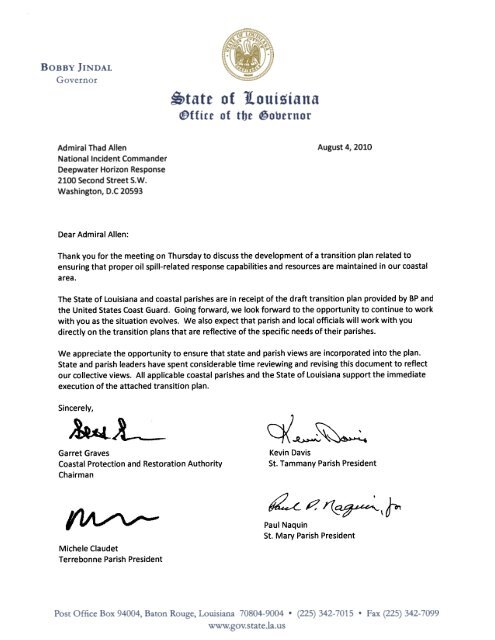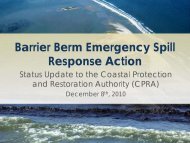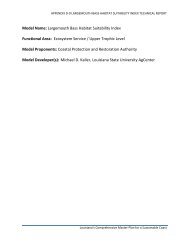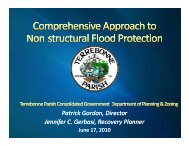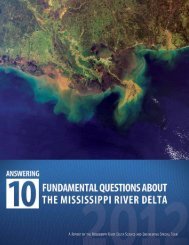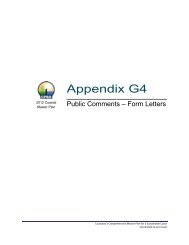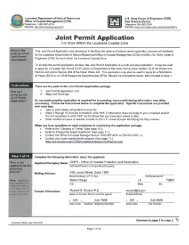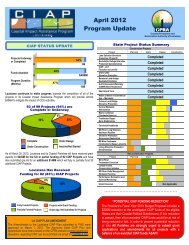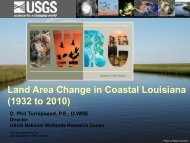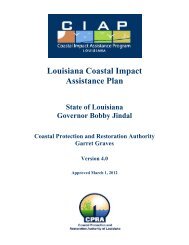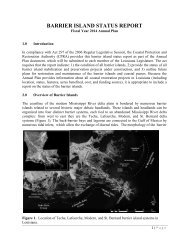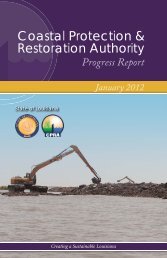Deepwater Horizon Response UAC Transition Plan - Coastal ...
Deepwater Horizon Response UAC Transition Plan - Coastal ...
Deepwater Horizon Response UAC Transition Plan - Coastal ...
You also want an ePaper? Increase the reach of your titles
YUMPU automatically turns print PDFs into web optimized ePapers that Google loves.
<strong>Deepwater</strong> <strong>Horizon</strong> <strong>Response</strong><br />
<strong>UAC</strong> <strong>Transition</strong> <strong>Plan</strong><br />
APPROVED:<br />
FOSC<br />
Date<br />
BP<br />
Date<br />
TOI<br />
Date<br />
BOEM<br />
Date<br />
AL SOSC<br />
Date<br />
FL SOSC<br />
Date<br />
LA SOSC<br />
Date<br />
MS SOSC<br />
Date<br />
1
<strong>Deepwater</strong> <strong>Horizon</strong> <strong>Response</strong><br />
<strong>UAC</strong> <strong>Transition</strong> <strong>Plan</strong><br />
The United States Coast Guard and BP acknowledge and pledge their support to the state<br />
and local parish authorities who are participating in the oil spill disaster response. The<br />
Coast Guard is to give great deference, to the extent possible based on scientific or<br />
otherwise objective consultation, to the local parishes during instances of operational<br />
disagreements between local authorities and BP.<br />
The Unified Command at the Incident Command Post in Houma, LA and the Area<br />
Command in New Orleans, LA, recognize the state and local parishs’ authority during the<br />
duration of the oil spill disaster/response and pledge that they be included throughout the<br />
decision making and planning process.<br />
This plan is designed to serve as the framework by which individual parish plans will be<br />
developed through direct negotiations with parish leaders.<br />
Overall Condition: Maintain immediate all zone response capability until<br />
Permanent Well Kill is completed. No change, without prior parish consent,<br />
regarding the status of response equipment for the remainder of hurricane season. Thirty<br />
days after the “Kill” is successfully completed, local municipal branches, parish<br />
president/mayor (or designee), the BP Branch Director and the USCG Branch Director<br />
will complete a joint inventory of all equipment, personnel, assets, and resources which<br />
will be used in the creation of a timeline for the demobilization of these assets. Resource<br />
readiness will also be maintained in the event of resumption of oil flow into the Gulf of<br />
Mexico. Resources will be repositioned to staging areas on parish approved high ground<br />
to prepare for severe weather contingencies, i.e., a Category 3 or higher storm.<br />
Critical Resources: Until the end of hurricane season the following critical resource<br />
capability is required:<br />
BP establish a recurring budget for each parish to utilize in planning and<br />
operational implementation and to embed a BP representative within each said<br />
branch with the appropriate authority to execute said budget.<br />
Maintain a 200% parish developed and Incident Command Post approved boom<br />
plan (total includes deployed on water, in staging areas, and warehoused).<br />
Personnel and Vessels of Opportunity will be adjusted based on actual operational<br />
requirements. Contracts are in place for the immediate and tiered increase of capability.<br />
Purpose: Develop a strategic plan to enact a tailored response to efficiently and<br />
effectively meet response needs as well as transition to long-term recovery. This plan<br />
will promote consistency across the command structure and adjust to operational<br />
demands while completing the following:<br />
2
• Maintain a Common Operational Picture (COP) across all ICP’s and Branches to<br />
support a unified and coordinated response.<br />
• A complete copy of all directives being sent from either BP or United States<br />
Coast Guard higher authority to the branch level directors is provided to the<br />
parish designated representative prior to implementation.<br />
• Develop a tiered approach to resource allocation, redeployment, and<br />
demobilization<br />
• Use the MC-252 well status, the location/amount of free oil on the water and<br />
shoreline conditions as key drivers. Based on:<br />
‣ SCAT data<br />
‣ Geospatial & Aerial observations of oil amount and distribution<br />
‣ On-water and shoreline recovery data<br />
‣ NOAA assessment & projections<br />
‣ State and federal commission of scientific experts develop and<br />
implement protocols for the detection, monitoring, and mediation<br />
of submerged oil. In the absence of such protocols, oil is presumed<br />
present.<br />
‣ Develop clear triggers for transition plan.<br />
• Coordinate all activities related to this transition plan among the NIC, <strong>UAC</strong>, and<br />
ICPs including the Parish Presidents or their designated representative.<br />
• Establish guidelines for scaling or repositioning people, contractors, equipment,<br />
and supplies to meet the needs of the incident.<br />
• Implement directives from the parish severe weather contingency plan as integral<br />
components of each level of response operations.<br />
Shoreline Cleanup Principles: Shoreline cleanup can generally be identified into 3 stages:<br />
1. Clean-up: personnel are onsite daily<br />
2. Monitor and React: Personnel are onsite every few days tending to deployed<br />
equipment (boom or other protective measures) or conducting limited cleanup.<br />
Hot-shot teams 1 will be deployed as needed to respond to new reports of<br />
oiling<br />
3. Natural Attenuation: All equipment removed and periodic site monitoring;<br />
may not be at clean-up end points.<br />
Guiding Principles:<br />
• Levels may revert based upon reoccurrence of conditions identified at any<br />
previous matrix<br />
• Be prepared to respond to all contingencies including weather and changing<br />
conditions and events<br />
• Maintain continuous and effective communications to sustain parish, state, and<br />
other stakeholder support.<br />
• Maintain efficiency and minimize waste through a well planned response with a<br />
clear concept of operation (COP).<br />
1 Hot-shot teams: Quick response teams available to respond to reports of new oiling, provide initial<br />
verification of report, and conduct clean-up and sampling as appropriate.<br />
3
• VOOs/local fishing fleet will be given priority over contracted OSROs in the demobilization<br />
of assets. VOOs/local fishing fleet shall be employed to maintain,<br />
remove and re-deploy all boom or other protective measures, conduct oil<br />
reconnaissance missions, handle on water logistics, etc.<br />
Action:<br />
1. Incident Commanders shall develop transition plans consistent with this strategic<br />
plan using the following guidelines:<br />
Recall times and estimated time to be on-scene shall be identified for all<br />
critical resources not currently in operational use until completion of hurricane<br />
season.<br />
<strong>UAC</strong> will assist with providing the identified measures to the ICP at each<br />
response level.<br />
The <strong>UAC</strong> will notify all ICs and branches when the permanent well kill is<br />
complete and resources may be adjusted to meet strategic and operational<br />
objectives.<br />
ICs shall report the current <strong>Response</strong> Level to the <strong>UAC</strong> Situation Unit daily;<br />
response levels should be further delineated for each Branch level.<br />
Branches may adjust the response structure as changes in operations and<br />
<br />
response levels dictate with parish approval.<br />
Specific plans for what assets and personnel will be de-mobilized must be<br />
developed and coordinated with each parish for each phase of the transition.<br />
2. Unified Area Command Staff and Section Chiefs and the Aviation Coordination<br />
Command, in coordination with the <strong>UAC</strong> Remote Sensing Coordinator, shall<br />
develop annexes consistent with the guidance of this plan.<br />
3. No changes in <strong>Response</strong> Levels will be executed without coordination and<br />
concurrence of the parish.<br />
4. Create a detail demobilization plan of the VOO’s to include a joint inspection of<br />
these vessels to determine if there are any damages that were a direct result of<br />
their response effort. A process must also be created to immediately create a<br />
claim for said damages<br />
5. Create a mutually agreed upon definition of when a shoreline is to be classified as<br />
“no further treatment.”<br />
6. Create a detailed monitoring plan that will address the following concerns:<br />
a. What long term monitoring will be conducted<br />
b. The frequency of the monitoring<br />
c. Who will conduct the monitoring<br />
d. A map of the sampling points<br />
e. The sampling method<br />
f. The parameters of the sampling and tests<br />
g. Access to the test results<br />
h. The term of the monitoring period<br />
4
Level I: All Zone <strong>Response</strong><br />
Status: Well cap in place no new <strong>Deepwater</strong> <strong>Horizon</strong> product discharging into the<br />
Gulf of Mexico. Recoverable oil in the water in the offshore and nearshore (all<br />
state jurisdictional waters) environment and impacting the shoreline.<br />
ACTIVITIES:<br />
‣ SCAT Shoreline Assessment conducted under Stage I and II Nearshore and<br />
Shoreline <strong>Response</strong> <strong>Plan</strong><br />
‣ Continue air operations to detect presence of recoverable oil.<br />
‣ Deploy full offshore, nearshore, and onshore recovery operations and protect<br />
shorelines<br />
ORGANIZATIONAL STRUCTURE<br />
‣ All zone response operation at NIC, <strong>UAC</strong>, and ICPs<br />
‣ Maintain parish branch directors.<br />
‣ Maintain parish BP and USCG liaison officers.<br />
TRIGGER TO ENACT LEVEL II: No recoverable offshore oil<br />
CONDITIONS: Sea conditions under four feet and southerly winds<br />
METRICS:<br />
o No observations of recoverable oil concentrations offshore (outside state<br />
jurisdictional waters) for 5 consecutive days<br />
o NOAA trajectories and models do not forecast any skimmable concentrations<br />
of offshore oil.<br />
o No submerged oil plumes have been detected per established protocols.<br />
MEASURES:<br />
o Reports from trained state and federal observers<br />
o Daily Incident Awareness and Assessment (IAA) Summary<br />
o Daily status map of NOAA aerial observation data (color coded) including<br />
number of total flights that created map and established submerged oil<br />
protocols.<br />
o NOAA trajectory<br />
o Satellite imagery of offshore oil (with short weather summary discussing<br />
potential impacts on image quality)<br />
5
Level II: Nearshore and Shoreline Assessment and Cleanup<br />
Status: No recoverable offshore zone (>3 miles) oil (on surface or submerged).<br />
ACTIVITIES:<br />
‣ Place offshore oil recovery operations in standby<br />
‣ Continue SCAT Shoreline Assessment conducted under Stage I and II Nearshore<br />
and Shoreline <strong>Response</strong> <strong>Plan</strong><br />
‣ Deploy nearshore and onshore recovery operations as necessary<br />
‣ Begin decontamination of offshore recovery vessels<br />
‣ Redeploy offshore skimming equipment to nearshore where possible<br />
‣ Recover nearshore floating or submerged oil and protect and clean shorelines<br />
‣ Continue to assess deployment of nearshore and onshore resources<br />
‣ Evaluate/implement appropriate boom or other protective measure strategies<br />
‣ Commence in water monitoring activities including tar ball, nearshore submerged<br />
oil, and biological studies to support fisheries opening<br />
ORGANIZATIONAL STRUCTURE<br />
‣ Scale branch staging areas appropriately as approved by parish<br />
‣ Scale ICPs & <strong>UAC</strong> appropriately<br />
‣ Maintain parish branch directors<br />
‣ Maintain parish BP and USCG liaison officers<br />
TRIGGER TO ENACT LEVEL III: No recoverable oil in water and no new<br />
significant shoreline impact for a period of six consecutive months.<br />
CONDITIONS: Sea conditions under four feet and southerly winds.<br />
METRICS:<br />
o No aerial, vessel, or shoreline observations of skimmable concentrations of oil<br />
on 5 consecutive days of full saturation observations.<br />
o NOAA trajectories and models do not forecast any skimmable concentrations<br />
of offshore or nearshore oil.<br />
o No submerged oil plumes or pods have been detected or collected per<br />
established protocols.<br />
MEASURE: Areas of recoverable oil identified in nearshore or onshore impact<br />
o Reports from trained state, federal, or local observers<br />
o Daily IAA Summary<br />
o Trend from Daily Status Map or any observation data<br />
o Satellite imagery of nearshore oil (with short weather summary discussing<br />
potential impacts on image quality)<br />
o Oil impact for total shoreline is considered “light”<br />
6
Level III: Detailed Cleanup to Achieve Completion<br />
Status: No recoverable oil in the nearshore environment. Remobilization of<br />
assets for episodic and intermittent oil recovery. No substantial re-oiling of<br />
shorelines.<br />
ACTIVITIES:<br />
‣ Decontaminate recovery vessels not in use.<br />
‣ Maintain air observation assets to include AVWATCH.<br />
‣ Continue execution of Boom Strategy<br />
‣ Re-baseline SCAT under Stage III Near Shore and Shoreline <strong>Response</strong> <strong>Plan</strong><br />
‣ Deploy Onshore recovery operations to implement SCAT Shoreline Treatment<br />
Recommendations (STRs)<br />
‣ Address intermittent nearshore re-oiling as required<br />
‣ Continue in water and shoreline monitoring.<br />
ORGANIZATIONAL STRUCTURE<br />
‣ Rescale organization based on termination of on-water recovery operations<br />
‣ Maintain parish branch directors<br />
‣ Maintain parish BP and USCG liaison officers<br />
TRIGGER TO ENACT LEVEL IV: All STRs have been completed such that further<br />
treatment would not provide net environmental benefit (NEB)<br />
METRICS:<br />
o No retrievable visible or submerged oil<br />
o No sheen releasing that will affect sensitive areas, wildlife, or human health<br />
MEASURE:<br />
o Percentage of shoreline miles signed off to be determined by federal, state<br />
and local authorities.<br />
o Percentage of shoreline miles with no further treatment (NFT) recommended.<br />
o Miles of shoreline signed off and miles of shoreline with NFT recommended.<br />
o Trend of percentage of oil impact for total shoreline (Heavy, Medium, Light,<br />
No oil.)<br />
7
Level IV: Maintenance and Monitoring<br />
Status: Clean-up methods fully implemented. Habitat-based clean-up end points<br />
met and signed off. Remaining shoreline segments designated as NFT in Level<br />
III move to Level IV. Episodic impacts and discovery of oil continues.<br />
ACTIVITIES:<br />
‣ Review all oil recovery resources<br />
‣ Natural attenuation of remaining oil<br />
‣ Conduct routine monitoring<br />
‣ SCAT surveys based on triggers relative to beach/shoreline profile (e.g. storm<br />
events)<br />
‣ Assess equipment needed based on operational needs<br />
‣ Develop and implement new STRs as determined through SCAT surveys<br />
‣ Deploy hot-shot teams to address episodic impacts and discovery of oil along<br />
shorelines or in near shoreline environment<br />
‣ Establish standard communication protocol with all effected parishes<br />
‣ Detailed SCAT survey of impacted shoreline segments<br />
‣ Signoff of shoreline segments where cleanup is complete<br />
‣ STRs developed as appropriate for remaining shoreline segments<br />
‣ Develop long-term monitoring and restoration plan for remaining shoreline<br />
segments which cannot be signed off.<br />
‣ Deploy hot-shot teams to address episodic impacts and discovery of oil along<br />
shorelines or in near shoreline environment<br />
ORGANIZATIONAL STRUCTURE<br />
‣ <strong>Response</strong> framework returns to pre-existing National <strong>Response</strong> System (NRS)<br />
structure where coordination of the response is at the Coast Guard Sector/FOSC<br />
level.<br />
‣ Maintain state liaison officer<br />
TRIGGER TO ENACT LEVEL V: Completion of winter storm season (Spring 2011)<br />
METRICS: To be determined.<br />
MEASURE:<br />
o Period for NFT segment re-evaluation<br />
o Percentage of miles of shoreline signed off<br />
o Number of monitoring and restoration projects identified for Level V<br />
o Parish rescinding of Declarations of Emergency<br />
8
Level V: End State Status: Long-term Monitoring and Restoration<br />
Status: Restoration complete. Episodic impacts and discovery of oil continues.<br />
ACTIVITIES:<br />
‣ On-going monitoring<br />
‣ Deploy hot-shot teams to address episodic impacts and discovery of oil along<br />
shorelines or in near shoreline environment<br />
Referenced or Associated <strong>Plan</strong>s: (To be Developed and Communicated Separately)<br />
a. Near Shore and Shoreline Stage I and II <strong>Response</strong> <strong>Plan</strong>; Mobile Sector: Approved<br />
May 8,2010<br />
b. Near Shore and Shoreline Stage I and II <strong>Response</strong> <strong>Plan</strong>; Louisiana Division<br />
Sector: Approved May 6,2010<br />
c. Decontamination <strong>Plan</strong><br />
d. Boom Strategy <strong>Plan</strong><br />
e. Severe Weather <strong>Plan</strong><br />
f. Near Shore and Shoreline Stage III <strong>Response</strong> <strong>Plan</strong>: To be developed<br />
g. Parish Severe Weather <strong>Plan</strong>s<br />
h. Parish Boom <strong>Plan</strong>s<br />
Annexes: (To be Developed and Communicated Separately)<br />
I. <strong>UAC</strong> Logistics Section <strong>Transition</strong> <strong>Plan</strong><br />
II. <strong>UAC</strong> External Affairs <strong>Transition</strong> <strong>Plan</strong><br />
III. Aircraft Coordination Command<br />
9
ADDITIONAL ITEMS FOR CONSIDERATION<br />
1. Need details on the determination of when a shoreline is to be classified as “no<br />
further treatment.”<br />
2. Detailed monitoring plan:<br />
a. What long term monitoring will be conducted<br />
b. The frequency of the monitoring<br />
c. Who will conduct the monitoring<br />
d. A map of the sampling points<br />
e. The sampling method<br />
f. The parameters of the sampling and tests<br />
g. Access to the test results<br />
h. The term of the monitoring period<br />
3. Information must be provided on the “hot shot” response plans, where the teams<br />
will be located, the required response item, the response trigger mechanisms, and the<br />
POC for response team activation.<br />
10


